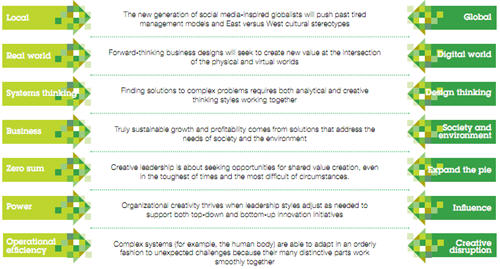The role of informal social networks in building organizational creativity and innovation
For the last decade I have examined and applied social network analysis in and across organizations, for example in large professional firms, technology purchase decision-making, high-performance personal networks, and other applications.
The more time you spend with the analysis of social networks in organizations and those firms that have applied the techniques, the more evident the power of these approaches. In particular for high-performing organizations, applying social network analysis is one of the most useful tools in pushing value creation to the next level. This is evident in the California Management Review paper I co-authored on Managing Collaboration: Improving Team Effectiveness through a Network Perspective, in which we examined how to improve performance in sales, innovation, and execution.
Innovation is of course a particularly pointed issue today, with the increasing pace of external and industry change driving the necessity of effective, applied creativity. However this is often difficult in large, complex organizations.
To this point, the IBM Institute for Business Value has released a report on Cultivating organizational creativity in an age of complexity.
The report has some interesting insights and findings, including this chart of the opposites needing resolution in a creative organization.

Source: IBM Creative Leadership Report
However what I particularly picked up on was the report’s references to the use of social network analysis. In the first instance it looked at its role in uncovering organizational capabilities for creativity. There is probably no better tool to identify both strengths and areas for intervention in innovation.
Uncovering the key capabilities of the creative organization
1. Assess the readiness for challenging assumptions in your organization
• Evaluate your culture, structures and organizational climate for creativity
• Identify the environmental factors that have contributed to past innovations
• Make results available to all and solicit input for improvement initiatives.2. Use social network analysis to uncover creative leadership
• Search the relationship networks in your organization to find future creative leaders
• Identify the social structure, including critical roles, of your creative leadership community
• Determine how these relationship networks have contributed to specific creative accomplishments in the past.3. Write the history of your organization’s most compelling innovations
• Focus on significant breakthroughs that created real value
• Plot out the path your organization followed in order to: see, map, understand, believe and act on past opportunities
• Write a “history” from the future envisioning how the organization’s three-year goals will be achieved using this same approach.
The report goes on to look at some key points in unleashing creativity. The first point on collective visualization of data is a very interesting one. It undoubtedly alludes to IBM’s Many Eyes initiative, which provides a platform to this. These kinds of tools can be very useful, but only if used well, which many organizations are not quite ready for.
It also discusses social network analytics in mapping collaboration. The approaches they describe can be very valuable, but I would generally do these earlier, designed in such as to identify specific high-impact initiatives. Social network analysis is a powerful tool, but it has to be applied with clear interventions in mind.
Unleash and scale organizational creativity
1. Improve transparency by sharing data for collective visualization
• Challenge your analytical and creative talents to design data so that it tells a story
• Publish data in a visual way that gains the benefit of collective sense-making
• Extend data visualization to scenario simulations that can be manipulated collectively.2. Establish a platform for creative collaboration
• Recruit global experts to engage with the members of your business ecosystem
• Enable ad hoc self-organization around value creation opportunities
• Encourage participation with a “leaders first” approach to the sharing of ideas.3. Use social analytics to understand and influence constituent behavior
• Create a real-time analytics engine that provides instant visibility to online actions
• Use experimentation and simulation to predict behavior under various scenarios
• Leverage game dynamics to influence behavior in both the virtual and physical worlds.
As creativity and innovation move to be even more central to value-creation in organizations, social network analysis will increasingly be used as a tool by those organizations that succeed in moving ahead.
